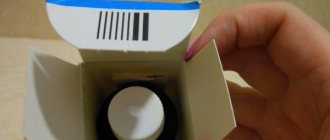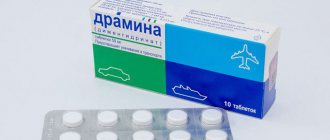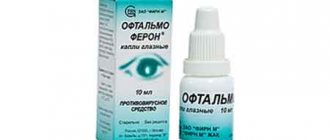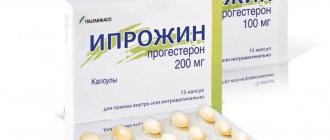Indications for use
- Mycoses caused by dermatophytes and yeasts that are sensitive to the action of the active substance (itraconazole);
- Dermatomycosis, pityriasis versicolor, keratitis of fungal origin, candidal lesions of the oral cavity, fungal lesions of the nail plates (onychomycosis);
- Vulvovaginal candidiasis;
- Cryptococcal lesions of the central nervous system in immunocompromised patients in cases where therapy with other drugs has been unsuccessful;
- Systemic mycoses, systemic aspergillosis or candidiasis, as well as cryptococcosis (including cryptococcal meningitis);
- Rare systemic and tropical mycoses, including histoplasmosis, sporotrichosis, paracoccidioidosis, blastomycosis and other fungal infections.
Contraindications
- Concomitant use with drugs metabolized by the CYP3A4 enzyme that prolong the QT interval (due to a possible increase in the level of itraconazole in the blood plasma, which can lead to a prolongation of the QT interval with the development of ventricular tachycardia);
- Concomitant use with drugs metabolized by the CYP3A4 enzyme, HMG-CoA reductase inhibitors, as well as drugs containing ergot alkaloids;
- Indications in the anamnesis of acute heart failure or other manifestations of ventricular dysfunction of the heart (except for conditions that threaten the patient’s life, or in the presence of pathogens that are resistant to therapy with other drugs);
- Hypersensitivity to the components of the drug.
Breastfeeding and pregnant women, as well as children, can take Itracon only under strict indications after assessing the benefit/risk ratio.
Directions for use and dosage
Itracon is taken orally without chewing. It is recommended to take the drug after meals (high-calorie foods promote better absorption).
The regimen for using the drug is determined by the indications:
- Fungal keratitis: 1 time per day, 2 capsules, course – 21 days;
- Oral candidiasis: 1 capsule 1 time per day, course – 15 days. The bioavailability of Itracon may be reduced in case of pathologies of the immune system, in which case it may require a dosage increase of 2 times;
- Pityriasis versicolor: 2 capsules 1 time per day, course – 7 days;
- Vulvovaginal candidiasis: it can be taken according to one of the following regimens - 2 times a day, 2 capsules, course - 1 day, or 1 time a day, 2 capsules, course - 3 days;
- Dermatomycoses: can be taken according to one of the following regimens - 1 time per day, 2 capsules, course - 7 days, or 1 time per day, 1 capsule, course - 15 days. Athlete's feet and hands, as well as other lesions with high keratinization: you can take one of the regimens - 2 times a day, 2 capsules, course - 7 days, or 1 time a day, 1 capsule, course - 30 days;
- Onychomycosis caused by dermatophytes and/or yeast (damages of the nail plates on the toes with or without simultaneous lesions on the hands, lesions of the nail plates only on the hands) can be taken according to one of the regimens - 1 time per day, 2 capsules, course - 7 days , which must be repeated after 21 days, or 1 time per day, 2 capsules, course – 3 months. In some cases, the doctor prescribes a regimen for using the drug individually. Due to the slow removal of Itracon from nails and skin tissue, the therapeutic effect is achieved only 14-28 days after the end of the course of treatment for skin lesions and 6-9 months after the end of the course of treatment for diseases of the nail plates.
When treating systemic mycoses, the following are usually prescribed:
- Aspergillosis – 2 capsules once a day, course – 2-5 months. In case of invasive or disseminated disease, it is possible to increase the frequency of dosing to 2 times a day;
- Candidiasis: 1-2 capsules once a day, course – from 3 weeks to 7 months. In case of invasive or disseminated disease, it is possible to increase the frequency of dosing to 2 times a day;
- Cryptococcosis (without symptoms of meningitis): 1 time per day, 2 capsules, course – 2-12 months;
- Cryptococcal meningitis: 2 times a day, 2 capsules, course – 2-12 months;
- Histoplasmosis: 1-2 times a day, 2 capsules, course – 8 months;
- Sporotrichosis: 1 capsule once a day, course – 3 months;
- Paracoccidioidomycosis: 1 capsule once a day, course – 6 months (there is insufficient data on the effectiveness of this dosage regimen in AIDS patients);
- Chromomycosis: 1-2 capsules once a day, course – 6 months;
- Blastomycosis: 1-2 times a day, 1-2 capsules, course – 6 months.
Pharmacological properties of the drug Itracon
Synthetic antifungal agent, triazole derivative. Inhibits the cytochrome P450-dependent synthesis of ergosterol, an essential component of the fungal cell membrane; has a fungicidal effect. Active against dermatophytes ( Trichophyton spp., Microsporum spp., Epidermophyton floccosum ), yeast fungi, including Candida spp. (including C. albicans, C.glabrata, C.krusei ), molds ( Criptococcus neoformans, Aspergillus spp., Histoplasma spp., Paracoccidioides brasiliensis, Sporothrix schenckii, Fonsecaea spp., Cladosporium spp., Blastomyces dermatitidis ) and other fungi. Absorbed into the gastrointestinal tract quite completely. Taking after meals increases the bioavailability of Itracon. The maximum concentration in the blood plasma is achieved after 3–4 hours, the equilibrium concentration (when prescribing 100–200 mg of itraconazole 1–2 times a day) is established after 1–2 weeks and is 0.4 mcg/ml (3–4 hours after last dose of the drug at a dose of 100 mg 1 time per day); 1.1 or 2 mcg/ml (when taken at a dose of 200 mg 1 or 2 times a day, respectively). Binds to plasma proteins by 99.8%. Penetrates into tissues and organs (including the vagina), determined in the secretions of the sebaceous and sweat glands, accumulates in the lungs, kidneys, liver, bones, stomach, spleen, skeletal muscles and especially in the skin: the concentration of itraconazole in these organs (tissues) exceeds that in blood plasma by 2–4 times. The therapeutic (antifungal) level of itraconazole in nail keratin is achieved within 1 week and persists for about 6 months after 3 months of treatment, in the skin - for 2–4 weeks after 4 weeks of taking the drug. It is biotransformed in the liver with the formation of a large number of metabolites, including the active one (hydroxyitraconazole). Elimination from blood plasma is biphasic, the half-life is 24–36 hours. It is excreted within 1 week through the intestines (3–18%) and the kidneys (35%).
Side effects
While taking Itracon, the following disorders may develop, occurring with varying frequency:
- Central nervous system: headache, peripheral neuropathy, paresthesia, hypoesthesia, dizziness;
- Gastrointestinal tract: often - dyspepsia, nausea, flatulence, abdominal pain, constipation, dysgeusia, diarrhea, vomiting;
- Immune system: serum sickness, anaphylactic and anaphylactoid reactions;
- Allergic reactions: skin itching, papular rash, urticaria, angioedema, Stevens-Johnson syndrome, inflammatory diseases of the upper respiratory tract, sinusitis, rhinitis, pulmonary edema, congestive heart failure;
- Lymphatic system and blood: in rare cases – leukopenia, neutropenia, thrombocytopenia;
- Musculoskeletal system and connective tissue: myalgia, arthralgia;
- Reproductive system: in women - menstrual cycle disorders, in men - erectile dysfunction;
- Metabolic disorders: hyperglyceridemia, hypokalemia;
- Visual organ: visual disturbances, including diplopia, blurred or gridded vision;
- Hearing organ: tinnitus, temporary or permanent hearing loss;
- Hepatobiliary system: severe toxic liver damage with the development of isolated cases of acute liver failure, a reversible increase in the activity of liver enzymes, hepatitis;
- Kidneys and urinary tract: pollakiuria and urinary incontinence;
- Skin and subcutaneous tissues: toxic epidermal necrolysis, erythema multiforme, exfoliative dermatitis, leukocytoclastic vasculitis, increased photosensitivity, alopecia;
- Other: swelling.
Antigrippin homeopathic
Viral infection is one of the common diseases, which, in the absence of timely treatment, can lead to complications that turn into chronic forms.
In the initial period of the disease, the virus multiplies in the entrance “gates of infection”: the nose, nasopharynx, larynx, which manifests itself in the form of pain, runny nose, soreness, and dry cough. Source: flickr (Evgeniy rumedicalnews).
The main place in the body’s safe fight against viruses is occupied by complex homeopathic preparations. The action of the substances included in these medications is aimed at restoring the body's defenses, eliminating infectious intoxication, removing swelling of the mucous membrane of the upper respiratory tract, tissue regeneration, and promoting health.
Homeopathic antigrippin is a combination drug that is available in two forms: for adults and for children. Prescribed for the treatment of inflammatory processes in the body resulting from a cold. The medicine contains natural ingredients that do not give an allergic reaction and do not cause side effects.
- Aconite (Aconitum) – is prescribed for fever, chills, cough, with pain radiating to the chest. It is taken for infectious intoxication of the body, inflammatory processes in the upper respiratory tract.
- Arsenicum – prescribed for purulent tissue inflammation, pneumonia, pleurisy.
- Rhus (Rhus toxicodendron) - prescribed for inflammatory processes during colds, dizziness, aching joints and bones, boils.
special instructions
Itrakon contains sugar, which must be taken into account when prescribing it to patients with diabetes.
With reduced stomach acidity, absorption of the active substance into the gastrointestinal tract worsens. When using Itracon simultaneously with antacid drugs (for example, aluminum hydroxide), a break of at least 2 hours should be observed.
In patients with achlorhydria or concomitant use of H2-blockers or proton pump inhibitors, Itracon is recommended to be taken with cola drinks.
The drug is not recommended for the primary treatment of emergency conditions that cause systemic fungal infections.
The need for maintenance therapy in patients with AIDS who have been treated for systemic mycoses (sporotrichosis, blastomycosis, histoplasmosis or cryptococcosis, including cryptococcal meningitis) and are at risk of developing a relapse is determined by the doctor individually.
Women of reproductive age must use reliable contraception during the entire course of therapy (before the onset of the first menstruation after its completion).
Itracon should not be taken by patients with congestive heart failure or a history of this disease unless the expected benefit significantly outweighs the potential risk. When individually assessing the benefit/risk ratio, the following factors should be taken into account: dosage regimen, indications, individual risk factors for the development of congestive heart failure (coronary heart disease, valve damage, chronic obstructive pulmonary disease, renal failure or other diseases accompanied by edema). Treatment should be carried out with caution, monitoring symptoms of congestive heart failure. If these symptoms develop, the use of Itracon should be discontinued.
Caution must be exercised when using Itracon simultaneously with calcium channel blockers.
It is recommended to monitor liver function while taking Itracon. If symptoms of hepatitis develop (anorexia, vomiting, nausea, increased fatigue, dark urine or abdominal pain), it is necessary to interrupt treatment and consult a doctor.
The bioavailability of Itracon when administered orally in patients with liver cirrhosis and renal failure is slightly reduced, so dose adjustment may be required.
If neuropathy develops, therapy should be interrupted.
Elderly patients are prescribed Itracon only in cases where the expected benefit is higher than the risk of using the drug.
The most common side effect of Itracon is diarrhea, which can cause a decrease in the absorption of the active substance and change the intestinal microflora, promoting the development of fungal colonization. In these cases, caution should be exercised when stopping treatment.
There are reports of temporary or permanent hearing loss in patients taking Itracon or Itracon simultaneously with quinidine (the combination of these drugs is contraindicated). As a rule, hearing is restored after stopping the drug, but in some cases, hearing loss may be irreversible.
Since dizziness may occur when using Itracon, during therapy it is recommended to refrain from driving vehicles and performing other work that requires high concentration.
Sagrippin® homeopathic
Sagrippin granules
Sagrippin is a homeopathic medicine intended to help fight colds in adults and children over 3 years of age. By stimulating the body's defenses, the product helps prevent the development of infection or cope with an existing illness. Numerous clinical studies of Sagrippin have confirmed not only its high effectiveness, but also its safety: the drug has no serious side effects and is practically free of contraindications.
Drug interactions
The simultaneous use of Itracon with certain drugs requires monitoring the level of their concentration in the blood plasma. When prescribing such combinations of drugs, monitoring the patient's condition and the development of side effects is required. Dose adjustment may also be required. With caution, Itracon is prescribed simultaneously with the following drugs:
- HIV protease inhibitors (indinavir, ritonavir, saquinavir);
- Oral anticoagulants;
- Some anticancer drugs (methotrexate, Vinca alkaloids, docetaxel, busulfan);
- Calcium channel blockers that are broken down by the enzyme CYP3A4 (verapamil, dihydropyridine);
- Some immunosuppressants (tacrolimus, cyclosporine, rapamycin);
- Some glucocorticosteroids (dexamethasone, budesonide, methylprednisolone);
- Some cardiac glycosides (digoxin);
- Other drugs belonging to different pharmaceutical groups (buspirone, carbamazepine, alfentanil, cilostazol, fentanyl, halofantrine, disopyramide, alprazolam, rifabutin, brotizolam, midazolam, ebastine, repaglinide, reboxetine, loperamide).
When Itracon is used simultaneously with certain medications, undesirable effects may occur:
- Rifampicin, phenytoin, rifabutin: a significant decrease in the effectiveness of Itracon due to decreased bioavailability (combination with drugs that induce enzymes of the cytochrome system is not recommended);
- CYP3A4 enzyme inhibitors (clarithromycin, indinavir, ritonavir, erythromycin and other antibacterial drugs): increased bioavailability of itraconazole;
- Calcium channel blockers: decreased metabolism, increased negative inotropic effect (this combination requires caution).
Itraconazole does not affect the metabolism of norethisterone and ethinyl estradiol and does not interact with the following drugs: fluvastatin, zidovudine, tolbutamide, imipramine, diazepam, propranolol, indomethacin, cimetidine, sulfamethazine.
Homeopathy Alcoy Acogrippin – review
On the first day of illness, I give children 5 granules, and adults 9 granules 5 times a day 30 minutes before meals or an hour after meals under the tongue. On the second day I look at how I feel, if there are significant improvements, then I can reduce the number of doses to 3 times, and if not, then on the second day I continue to take Acogrippin according to the same regimen.
Dosage form
Other analgesics and antipyretics. Acitylsalicylic acid in combination with other drugs.
Release form, composition and packaging
◊ Homeopathic granules are homogeneous, regular spherical in shape, white, white with a grayish or white with a yellowish tint, odorless.
| Aconitum napellus (Aconitum) D3 |
| Aconitum napellus (aconitum napellus (aconitum)) D12 |
| Atropa bella-donna (Belladonna) D6 |
| Bryonia (bryonia) D3 |
| Bryonia (bryonia) D12 |
| Lachesis mutus (Lachesis) (lachesis mutus (lachesis)) D12 |
| Eupatorium perfoliatum (Eupatorium perfoliatum) D3 |
| Toxicodendron quercifolium (Rhus toxicodendron) (Rus toxicodendron) D30 |
| Phosphorus (phosphorus) D6 |
Excipients:
sugar granules (refined sugar, starch syrup) 100 g.
15 g – polymer jars (1) – cardboard packs. 30 g – polymer jars (1) – cardboard packs. 50 g – polymer jars (1) – cardboard packs.
Excipients:
sugar granules (refined sugar, starch syrup) 100 g.
Indications for use
The drug Nolgripp is used for the symptomatic treatment of infectious and inflammatory diseases (ARVI, influenza), accompanied by high temperature, fever, headache and muscle pain, runny nose, nasal congestion
The drug Nolgripp is used for the symptomatic treatment of infectious and inflammatory diseases (ARVI, influenza), accompanied by high temperature, fever, headache and muscle pain, runny nose, nasal congestion









